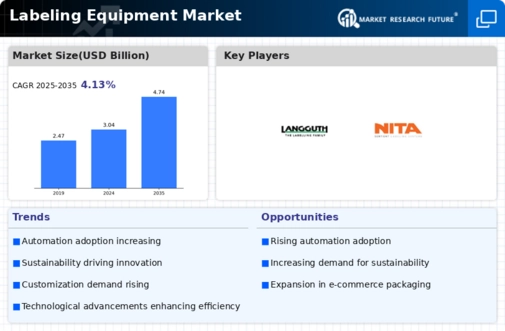Market Trends
Key Emerging Trends in the Labeling Equipment Market
Labelling outsourcing industry is just riding on certain noteworthy industry trends that fundamentally alter the space and create friction in the supply chain. The growing number of these innovations in labeling processes is another thing worth mentioning. To eliminate all possible errors with labels’ printings and to increase the productivity, companies are widely using automatic labeling machines. This conversion is undertaken to facilitate hassle-free performance at increased speeds and accurate labeling. Automated labeling should help to fasten the procedures and make the number of human-made mistakes lower what all ses to the economical benefits of the companies.
Natural product constitutes another feature that is prevailing in the Labeling Equipment Market which is reflected in the growing accent on sustainable and green label options. Along with the increase of environmental consciousness, the manufacturers are aiming at labeling equipment that can support their sustainability agenda. Such is evident in the convenience of companies buying eco-friendly labeling materials, the efficiency of the labeling machinery (energy-efficient) and on-the-go labeling systems. There is an industry movement towards integrating new and forward thinking technologies and materials that provides a lower carbon footprint into the labeling applications, agreeing with the objectives of a global community to promote green and sustainable ways to run a business operation.
Another important trend is that of smart labeling solution which is also gaining more popularity these days in the market. Nowadays, as the word of mouth “Industry 4.0” and “The Internet of Things” (IoT) become more commonplace, labeling machines are simultaneously acquiring smart functions. They enhance and streamline labeling strategies incorporating linkage and data analysis into the overall labeling procedure. The preferred trend in business is identification of equipment which facilitate real time reporting, forecasting of impending problems and finite capacity to adjust according to changing production parameters. More efficient productivity isn't only one of the benefits but also offers indispensable data for the laveling operation quality control.
Secondly, the most obvious change these months have brought is a switchover in the modular labeling designs. Versatility as well as adaptability of modular systems, at the same time, represent the most appealing features to companies that face diverse labeling requirements. Modular labeling systems which are made to order makes it possible for you to tailor-made your labeling procedures according to your specific product needs and it can as well deal with ranges of motifs with different sizes, materials, or shapes. This flexibility, rather than only boosting efficiency, helps to assure longevity of labeling, functioning hand in hand with businesses that are dealing with daily changes of requirements and production phases.
The User-Interface Side Of The Labeling Equipment Market Is Also Also Currently Turning Into Simple And Intuitive. The manufacturers have come to acknowledge that ease of use is an essential criterion in the design of classifying devices, which has led to the invention of machines with the ability to enable the users to master them pretty fast. The reason of this tendency is the goal to decrease the rescue crew performance time upgrading and thus the project of their operation errors.






Leave a Comment